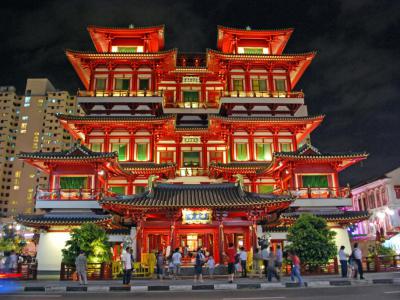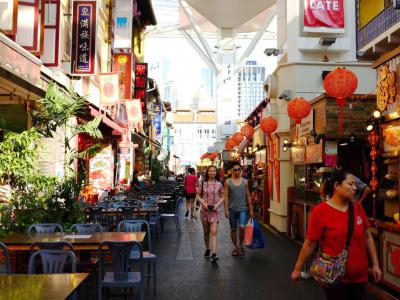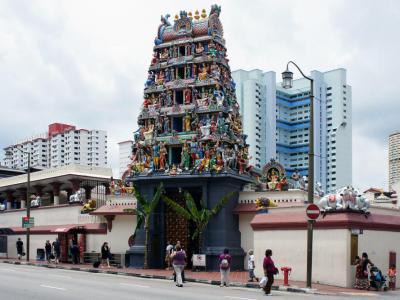
Chinatown Walking Tour (Self Guided), Singapore
Ethnic Chinese make up the majority of the Singaporean population. Therefore, it's no wonder that Chinatown is one of the top tourist destinations in the city. This vibrant and culturally rich neighborhood is steeped in history and tradition and is home to several iconic landmarks.
Undoubtedly, the most prominent of them is the Buddha Tooth Relic Temple & Museum, housing a sacred relic of Buddha's tooth. This fact alone is enough to make it a must-visit site.
Smith Street, also known as Chinatown Food Street, is a bustling food haven that showcases Singapore's diverse culinary scene. Here, you can savor a wide array of delicious Chinese dishes and street snacks – an absolute gastronomic delight for food enthusiasts!
The Chinatown Heritage Center is a museum that offers insight into the lives of early Chinese immigrants in Singapore: their struggles, aspirations, and contributions to the nation's development.
In addition to its Chinese heritage, Singapore's Chinatown is also home to other religious landmarks, such as the Sri Mariamman Temple, the oldest Hindu temple in the city, and the Jamae Mosque, a historic mosque that reflects the harmonious coexistence of different faiths in the area. Another notable place of worship, standing out with its intricate architectural detail, is the Taoist Thian Hock Keng Temple.
Meanwhile, the Fuk Tak Chi Museum is a true historical gem, showcasing artifacts illuminating Chinatown's early days.
A visit to Singapore's Chinatown promises a captivating journey through history, culture, and gastronomy. It's a place where you can explore the different aspects of Singapore's Chinese community simultaneously. So, don't miss the opportunity to broaden your horizons and have a good time using our self-guided tour!
Undoubtedly, the most prominent of them is the Buddha Tooth Relic Temple & Museum, housing a sacred relic of Buddha's tooth. This fact alone is enough to make it a must-visit site.
Smith Street, also known as Chinatown Food Street, is a bustling food haven that showcases Singapore's diverse culinary scene. Here, you can savor a wide array of delicious Chinese dishes and street snacks – an absolute gastronomic delight for food enthusiasts!
The Chinatown Heritage Center is a museum that offers insight into the lives of early Chinese immigrants in Singapore: their struggles, aspirations, and contributions to the nation's development.
In addition to its Chinese heritage, Singapore's Chinatown is also home to other religious landmarks, such as the Sri Mariamman Temple, the oldest Hindu temple in the city, and the Jamae Mosque, a historic mosque that reflects the harmonious coexistence of different faiths in the area. Another notable place of worship, standing out with its intricate architectural detail, is the Taoist Thian Hock Keng Temple.
Meanwhile, the Fuk Tak Chi Museum is a true historical gem, showcasing artifacts illuminating Chinatown's early days.
A visit to Singapore's Chinatown promises a captivating journey through history, culture, and gastronomy. It's a place where you can explore the different aspects of Singapore's Chinese community simultaneously. So, don't miss the opportunity to broaden your horizons and have a good time using our self-guided tour!
How it works: Download the app "GPSmyCity: Walks in 1K+ Cities" from Apple App Store or Google Play Store to your mobile phone or tablet. The app turns your mobile device into a personal tour guide and its built-in GPS navigation functions guide you from one tour stop to next. The app works offline, so no data plan is needed when traveling abroad.
Chinatown Walking Tour Map
Guide Name: Chinatown Walking Tour
Guide Location: Singapore » Singapore (See other walking tours in Singapore)
Guide Type: Self-guided Walking Tour (Sightseeing)
# of Attractions: 7
Tour Duration: 1 Hour(s)
Travel Distance: 1.4 Km or 0.9 Miles
Author: vickyc
Sight(s) Featured in This Guide:
Guide Location: Singapore » Singapore (See other walking tours in Singapore)
Guide Type: Self-guided Walking Tour (Sightseeing)
# of Attractions: 7
Tour Duration: 1 Hour(s)
Travel Distance: 1.4 Km or 0.9 Miles
Author: vickyc
Sight(s) Featured in This Guide:
- Buddha Tooth Relic Temple & Museum
- Smith Street (Chinatown Food Street)
- Chinatown Heritage Center
- Sri Mariamman Temple
- Jamae Mosque
- Thian Hock Keng Temple
- Fuk Tak Chi Museum
1) Buddha Tooth Relic Temple & Museum (must see)
Located in Singapore's Chinatown, this opulent cultural monument is cherished by the local Chinese who make up the overwhelming majority of the city-state's population. The temple's majestic outside appearance is equally matched on the inside.
Always lit up at night, it is open to visitors 24 hours a day. The dress code is strict and demands women to cover their shoulders, with a conservative dress or slacks advised for the lower part. Likewise, men are prohibited from wearing shorts or tank-tops, but oddly enough shoes are permitted for all, as are non-flash photos in some places.
Locals go in to pray regularly and you may find here a monk conducting a prayer or chanting in a microphone quite often. Set in the rear are the statues of Buddhas each overseeing a certain astrological sign, but the key figure in the main hall is Maitreya, a Buddha that is yet to come to Earth, the wooden statue of which here is believed to be 1,000 years old.
One of the temple's floors is fully filled with statues, among which is that of Guan Yin – Chinese Bodhisattva, Goddess of Compassion, Mercy and Kindness. Further up, in the mezzanine, there are life-sized wax sculptures of present and past leaders of the Temple – quite rich in detail actually (even showing wrinkles on hands!) and fit to rival any wax museum in the world. Also here is a balcony from which one can observe, through the drapes, the huge main prayer room down below, on the 1st floor.
Finally, the 4th floor is where the ultimate treasure of the temple is found – the Sacred Buddha Tooth Relic Stupa reportedly containing a tooth of Gautama Buddha himself, discovered in 1980 at a Burmese monastery. Now encased in a golden chamber behind glass panels, it can't be inspected up close, but there is an accompanying scale model at the front which can be viewed at any time.
Another must-see within the temple is the orchid garden on the rooftop featuring an enormous “prayer wheel” inside a pavilion of 10,000 small Buddhas lining the walls. Most people aren't aware of this garden, so it is very quiet and relaxing up here – an ideal setting for reflection prior to hitting the streets of Singapore's Chinatown once again.
Tip:
Non-flash-photos are permitted in some places, but not in the relic chamber.
Always lit up at night, it is open to visitors 24 hours a day. The dress code is strict and demands women to cover their shoulders, with a conservative dress or slacks advised for the lower part. Likewise, men are prohibited from wearing shorts or tank-tops, but oddly enough shoes are permitted for all, as are non-flash photos in some places.
Locals go in to pray regularly and you may find here a monk conducting a prayer or chanting in a microphone quite often. Set in the rear are the statues of Buddhas each overseeing a certain astrological sign, but the key figure in the main hall is Maitreya, a Buddha that is yet to come to Earth, the wooden statue of which here is believed to be 1,000 years old.
One of the temple's floors is fully filled with statues, among which is that of Guan Yin – Chinese Bodhisattva, Goddess of Compassion, Mercy and Kindness. Further up, in the mezzanine, there are life-sized wax sculptures of present and past leaders of the Temple – quite rich in detail actually (even showing wrinkles on hands!) and fit to rival any wax museum in the world. Also here is a balcony from which one can observe, through the drapes, the huge main prayer room down below, on the 1st floor.
Finally, the 4th floor is where the ultimate treasure of the temple is found – the Sacred Buddha Tooth Relic Stupa reportedly containing a tooth of Gautama Buddha himself, discovered in 1980 at a Burmese monastery. Now encased in a golden chamber behind glass panels, it can't be inspected up close, but there is an accompanying scale model at the front which can be viewed at any time.
Another must-see within the temple is the orchid garden on the rooftop featuring an enormous “prayer wheel” inside a pavilion of 10,000 small Buddhas lining the walls. Most people aren't aware of this garden, so it is very quiet and relaxing up here – an ideal setting for reflection prior to hitting the streets of Singapore's Chinatown once again.
Tip:
Non-flash-photos are permitted in some places, but not in the relic chamber.
2) Smith Street (Chinatown Food Street) (must see)
Singapore's Chinatown abounds in eateries of various sort which are particularly diverse in the heart of the area, right on and around South Bridge Road. A few touts on Smith Street will try to lure you into some foreigner-friendly restaurants, all decent enough if not the best in their class, and varied enough to eat something different every day for a few weeks. So if you want a great selection of different Asian cuisines, head to Smith Street and dine your way around South East Asia with ease. Give the hawker stalls along the road a miss if looking for genuine local food, even though they're also quite delicious and relatively cheap.
You could start off the day with a Michelin-star hawker lunch at Liao Fan Hawker Chan; next, you could leave the restaurant and roam the streets for unique souvenirs that are much cheaper and affordable, compared to other places. There are several tea shops, craft beer stalls, and many other Chinese shops set in the historical shop-houses, and you will also be able to buy a Durian fruit here or taste Durian ice cream if you're feeling adventurous.
Wherever you choose to go, you won't feel intimidated or pressurized to buy unlike in many other countries. Curiously enough for a street with so much authentic fare, Smith Street is the only street in Chinatown with an English name.
You could start off the day with a Michelin-star hawker lunch at Liao Fan Hawker Chan; next, you could leave the restaurant and roam the streets for unique souvenirs that are much cheaper and affordable, compared to other places. There are several tea shops, craft beer stalls, and many other Chinese shops set in the historical shop-houses, and you will also be able to buy a Durian fruit here or taste Durian ice cream if you're feeling adventurous.
Wherever you choose to go, you won't feel intimidated or pressurized to buy unlike in many other countries. Curiously enough for a street with so much authentic fare, Smith Street is the only street in Chinatown with an English name.
3) Chinatown Heritage Center
Located within three beautifully-restored shophouses on Pagoda Street, the Chinatown Heritage Centre tells the stories of Singapore’s past.
The center really gives you an insight into the life of the Straits Chinese who came to Singapore, living in the shophouses and carry on their trade in a single room shared with all their family members. The recreations of the various trades plied by this hardworking community - tailor, shoemaker, dressmaker, doctor etc. - together with the communal kitchen and toilet areas is a real eye opener into their living conditions in the 1950s.
The audio guide explains who lived behind the shop front and house, and how the tailor, apprentices and his family worked and lived together as well as the coolies and Samsui women in the floors above.
In addition to its exhibits, the Chinatown Heritage Centre holds various workshops and story-telling sessions for visitors who want to learn about the Chinatown history. Those looking to bring home a memento can find a range of books, postcards and prints by local artists.
The center really gives you an insight into the life of the Straits Chinese who came to Singapore, living in the shophouses and carry on their trade in a single room shared with all their family members. The recreations of the various trades plied by this hardworking community - tailor, shoemaker, dressmaker, doctor etc. - together with the communal kitchen and toilet areas is a real eye opener into their living conditions in the 1950s.
The audio guide explains who lived behind the shop front and house, and how the tailor, apprentices and his family worked and lived together as well as the coolies and Samsui women in the floors above.
In addition to its exhibits, the Chinatown Heritage Centre holds various workshops and story-telling sessions for visitors who want to learn about the Chinatown history. Those looking to bring home a memento can find a range of books, postcards and prints by local artists.
4) Sri Mariamman Temple
Singapore’s oldest Hindu shrine, the Sri Mariamman Temple, is easily identified by the superb entrance “gopura” bristling with brightly colored deities. Located in the Chinatown district, the temple serves the majority Hindu Singaporeans, known as Tamilians.
Once inside, look up at the roof and you will see splendid friezes depicting a host of Hindu deities, including the three manifestations of the supreme being: Brahma the creator, with three of his four heads showing; Vishnu the preserver, and Shiva the destroyer, the latter holding one of his sons. The main sanctum, facing you as you walk inside the temple, is devoted to Mariamman, a goddess worshiped for her healing powers. Smaller sanctums dotted all around the temple's walkway honor a number of other deities. In the one dedicated to the goddess Periachi Amman, a sculpture portrays her with a queen lying on her lap, whose evil child she has ripped from her womb, which is most interesting given that Periachi Amman is the protector of children, to whom babies are brought when they're only one month old. Sri Aravan, with his bushy mustache and big ears, is far less intimidating and his sanctum is at the back of the complex.
To the left of the main sanctum is a patch of sand which once a year, during the festival of Thimithi (in October or November), is covered in red-hot coals that male Hindus run across to prove the strength of their faith. The participants, who line up all the way along South Bridge Road waiting for their turn, are supposedly protected from the heat of the coals by the power of prayer.
If you go during certain times you will see different interesting rituals almost every day. Visiting here is guaranteed to be a great, culturally-enlightening experience. As in any place of worship, you must be respectful toward locals and follow their lead. Lowered voices, covered shoulders, and removed shoes are generally required, but bringing a pair of socks would probably help the more sensitive, as the floors can be scorching hot due to the sun and burn the feet.
Why You Should Visit:
If you go during certain times you will see different interesting rituals almost every day.
Visiting here is guaranteed to be a great, culturally-enlightening experience.
Free to enter though there's a small charge for tourists – called a "camera fee".
Tip:
As in any place of worship, you must be respectful toward locals and follow their lead. Lowered voices, covered shoulders, and removed shoes are generally required, but bringing a pair of socks would probably help the more sensitive, as the floors can be scorching hot due to the sun and burn the feet.
Once inside, look up at the roof and you will see splendid friezes depicting a host of Hindu deities, including the three manifestations of the supreme being: Brahma the creator, with three of his four heads showing; Vishnu the preserver, and Shiva the destroyer, the latter holding one of his sons. The main sanctum, facing you as you walk inside the temple, is devoted to Mariamman, a goddess worshiped for her healing powers. Smaller sanctums dotted all around the temple's walkway honor a number of other deities. In the one dedicated to the goddess Periachi Amman, a sculpture portrays her with a queen lying on her lap, whose evil child she has ripped from her womb, which is most interesting given that Periachi Amman is the protector of children, to whom babies are brought when they're only one month old. Sri Aravan, with his bushy mustache and big ears, is far less intimidating and his sanctum is at the back of the complex.
To the left of the main sanctum is a patch of sand which once a year, during the festival of Thimithi (in October or November), is covered in red-hot coals that male Hindus run across to prove the strength of their faith. The participants, who line up all the way along South Bridge Road waiting for their turn, are supposedly protected from the heat of the coals by the power of prayer.
If you go during certain times you will see different interesting rituals almost every day. Visiting here is guaranteed to be a great, culturally-enlightening experience. As in any place of worship, you must be respectful toward locals and follow their lead. Lowered voices, covered shoulders, and removed shoes are generally required, but bringing a pair of socks would probably help the more sensitive, as the floors can be scorching hot due to the sun and burn the feet.
Why You Should Visit:
If you go during certain times you will see different interesting rituals almost every day.
Visiting here is guaranteed to be a great, culturally-enlightening experience.
Free to enter though there's a small charge for tourists – called a "camera fee".
Tip:
As in any place of worship, you must be respectful toward locals and follow their lead. Lowered voices, covered shoulders, and removed shoes are generally required, but bringing a pair of socks would probably help the more sensitive, as the floors can be scorching hot due to the sun and burn the feet.
5) Jamae Mosque
Jamae Mosque stands as one of the earliest mosques in Singapore, situated along South Bridge Road within the Chinatown district, nestled within the Central Area. Founded by Chulias from the Tamil Muslim community on South India's Coromandel Coast, Singapore's Jamae Mosque was the first of three mosques established by these traders and money changers. The original mosque was built around 1826 under Ansar Saib's leadership on South Bridge Road, and the current Jamae Mosque was constructed on the same site between 1830 and 1835.
Remarkably, the current structure has remained largely unchanged since its completion in 1835, despite two proposals for its reconstruction. In 1996, repair work was carried out on the mosque. While Jamae Mosque is oriented towards Mecca, its compound aligns with the surrounding street grid.
Architecturally, the mosque exhibits an eclectic style that mirrors the architectural trends of 1830s Singapore. The entrance gate distinctly reflects South Indian influences, while the two prayer halls and the shrine adopt a Neo-Classical style reminiscent of the work of George Drumgoole Coleman, the first trained architect in Singapore. This unique blend of architectural elements has made Jamae Mosque an iconic and frequently photographed landmark, appearing on postcards dating back to the 19th century up to the present day.
Recognizing its historical significance, Jamae Mosque was designated a National Monument on November 19, 1974, underscoring its enduring cultural and historical value.
Remarkably, the current structure has remained largely unchanged since its completion in 1835, despite two proposals for its reconstruction. In 1996, repair work was carried out on the mosque. While Jamae Mosque is oriented towards Mecca, its compound aligns with the surrounding street grid.
Architecturally, the mosque exhibits an eclectic style that mirrors the architectural trends of 1830s Singapore. The entrance gate distinctly reflects South Indian influences, while the two prayer halls and the shrine adopt a Neo-Classical style reminiscent of the work of George Drumgoole Coleman, the first trained architect in Singapore. This unique blend of architectural elements has made Jamae Mosque an iconic and frequently photographed landmark, appearing on postcards dating back to the 19th century up to the present day.
Recognizing its historical significance, Jamae Mosque was designated a National Monument on November 19, 1974, underscoring its enduring cultural and historical value.
6) Thian Hock Keng Temple
To get a glimpse of a culture that is absolutely out of the ordinary, visit Thian Hock Keng, the oldest Hokkien temple in Singapore whose name literally translates to the "Palace of Heavenly Happiness". Now skillfully restored, the temple was constructed in the 19th century in the Southern Chinese architectural style, without any use of nails and with all the materials imported from China. It stands on the site of a small house where immigrants made offerings to Ma Cho Po, aslo known as Mazu [Ma-tsu] in Mandarin, regarded by her worshipers as a powerful and benevolent Queen of Heaven whose statue, also shipped in from China, was set here in time for the temple’s inauguration in 1842. It now stands in the center of the main hall, flanked by the God of War on the right and the Protector of Life on the left.
From the street, the temple looks quite spectacular, with dragons stalking its broad roofs, and the entrance to the temple compound bristling with ceramic flowers, foliage and figures. Specifically, the side entrance gates feature brightly colored tiles portraying peacocks, roses and the Buddhist swastika motif symbolizing good luck, eternity and immortality. Two stone lions, traditional sentinels of any Taoist temple, stand guard at the entrance while the door gods, painted on the front doors, prevent evil spirits from entering.
Beyond this elaborate entrance are two courtyards, straddling which is the temple proper, comprising the shrine of Ma Cho Po. On either side of the temple are pagodas – the one on the left is a shrine of Confucius, and the one on the right houses ancestral tablets of immigrants who founded the temple. Look out for signboards to better understand the significance of various motifs found in all parts of the temple. Look out, too, for the huge ovens, always lit, in which offerings to either gods or ancestors are burnt.
The story of the Chinese immigrants who, in the early 1900s, left their hometowns in Southern China for Singapore in search of a better life is very nicely painted as a wall mural that runs the entire length of the temple's back wall along Amoy Street, so don't forget to check it out before leaving.
Why You Should Visit:
Very peaceful atmosphere and a wonderful piece of Asian architecture.
A photographer's dream, with ornate and colorful carvings everywhere.
Tip:
Make sure that you respect the privacy of those praying and only take photos in the front area.
Located literally next door to the temple is an Indian Muslim Mosque – the Nagore Dargah.
From the street, the temple looks quite spectacular, with dragons stalking its broad roofs, and the entrance to the temple compound bristling with ceramic flowers, foliage and figures. Specifically, the side entrance gates feature brightly colored tiles portraying peacocks, roses and the Buddhist swastika motif symbolizing good luck, eternity and immortality. Two stone lions, traditional sentinels of any Taoist temple, stand guard at the entrance while the door gods, painted on the front doors, prevent evil spirits from entering.
Beyond this elaborate entrance are two courtyards, straddling which is the temple proper, comprising the shrine of Ma Cho Po. On either side of the temple are pagodas – the one on the left is a shrine of Confucius, and the one on the right houses ancestral tablets of immigrants who founded the temple. Look out for signboards to better understand the significance of various motifs found in all parts of the temple. Look out, too, for the huge ovens, always lit, in which offerings to either gods or ancestors are burnt.
The story of the Chinese immigrants who, in the early 1900s, left their hometowns in Southern China for Singapore in search of a better life is very nicely painted as a wall mural that runs the entire length of the temple's back wall along Amoy Street, so don't forget to check it out before leaving.
Why You Should Visit:
Very peaceful atmosphere and a wonderful piece of Asian architecture.
A photographer's dream, with ornate and colorful carvings everywhere.
Tip:
Make sure that you respect the privacy of those praying and only take photos in the front area.
Located literally next door to the temple is an Indian Muslim Mosque – the Nagore Dargah.
7) Fuk Tak Chi Museum
The Fuk Tak Chi Temple, also known as Fook Tet Soo Khek Temple, stands as one of the oldest former temples in Singapore. Today, it serves as a museum that houses a remarkable collection of over 200 historical artifacts.
This temple was originally constructed in 1820 by Cantonese and Hakka immigrants who had settled in Singapore. In 1825, it underwent a significant reconstruction, during which it was built using bricks. In 1854, two additional Hakka clans, Fong Yun Thai and Ying Fo Fui Kun, actively participated in the rebuilding project. The temple is dedicated to Tua Pek Kong and functions as a place of worship for both Chinese folk religionists and Taoists. Over time, it expanded its role, also serving as an association that catered to the needs of the broader Chinese community.
In 1995, the temple was designated for preservation and adaptive reuse by the Urban Redevelopment Authority. It was handed over to the Far East Organisation, along with Chui Eng Free School and other adjacent shophouses.
In August 1998, extensive restoration work was undertaken, transforming the building into a museum. The museum's exhibits focus on the lives of early Chinese migrants in Singapore. Subsequently, in the year 2000, it became an integral part of the new Far East Square development.
This temple was originally constructed in 1820 by Cantonese and Hakka immigrants who had settled in Singapore. In 1825, it underwent a significant reconstruction, during which it was built using bricks. In 1854, two additional Hakka clans, Fong Yun Thai and Ying Fo Fui Kun, actively participated in the rebuilding project. The temple is dedicated to Tua Pek Kong and functions as a place of worship for both Chinese folk religionists and Taoists. Over time, it expanded its role, also serving as an association that catered to the needs of the broader Chinese community.
In 1995, the temple was designated for preservation and adaptive reuse by the Urban Redevelopment Authority. It was handed over to the Far East Organisation, along with Chui Eng Free School and other adjacent shophouses.
In August 1998, extensive restoration work was undertaken, transforming the building into a museum. The museum's exhibits focus on the lives of early Chinese migrants in Singapore. Subsequently, in the year 2000, it became an integral part of the new Far East Square development.
Walking Tours in Singapore, Singapore
Create Your Own Walk in Singapore
Creating your own self-guided walk in Singapore is easy and fun. Choose the city attractions that you want to see and a walk route map will be created just for you. You can even set your hotel as the start point of the walk.
Colonial District Walking Tour
Singapore emerged as the British India Company's trading post in Southeast Asia in the early 19th century. The Colonial District of Singapore, also known as the Civic District, is a historical gem reflecting the island nation's colonial past. Spread across the banks of the Singapore River, the European-style buildings in the area attest to that period.
One prominent landmark here is... view more
Tour Duration: 1 Hour(s)
Travel Distance: 1.7 Km or 1.1 Miles
One prominent landmark here is... view more
Tour Duration: 1 Hour(s)
Travel Distance: 1.7 Km or 1.1 Miles
Singapore Introduction Walking Tour
Malay legend has it that a long time ago the Sumatran prince, who sought shelter from a storm, ended up on the island of Temasek where he saw a strange animal believed to be a lion. He then founded a city there and named it Singapura which in Sanskrit means the “Lion City”. In the 14th century, Singapura found itself “between a rock and a hard place” when the neighboring realms of Thailand... view more
Tour Duration: 2 Hour(s)
Travel Distance: 3.5 Km or 2.2 Miles
Tour Duration: 2 Hour(s)
Travel Distance: 3.5 Km or 2.2 Miles
Useful Travel Guides for Planning Your Trip
12 Singapore Foods You Should Not Miss
Food is a national passion for Singaporeans. Locals think and talk about food incessantly, often thinking nothing of travelling for miles across the island and queuing for hours just to taste one of their favourite dishes.
Singaporeans abroad will bemoan being parted from their favourite foods,...
Traveler's Guide to Singapore: 15 Souvenirs to Bring Home
Known as one of the Four Asian Tigers (or Dragons), Singapore is a thriving metropolis and one of the most fascinating tourist destinations in Asia. Home to multi-ethnic community, the city carefully preserves and proudly exhibits its colorful identity, manifested - among other forms - in the...
The Most Popular Cities
/ view all











